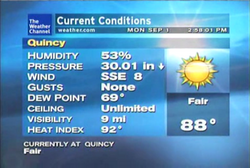Engineering:Weather Star XL
| Weather Star XL | |
|---|---|
 | |
| Manufacturer: | Silicon Graphics |
| Family: | WeatherStar |
| Hardware: | SGI O2 |
| OS: | IRIX 6.3 |
| Graphics: | Vector/Raster |
| Release date: | Beta – 3Q 1998 Final – 1Q 1999 |
| Status: | Retired – officially as of 2014-06-26 |
| Versions: | 1, 2 and 3 |
| Visual output: | Standard definition |
| Available add-ons | Vocal Local |
Weather Star XL is the fifth generation of the WeatherStar systems used by the American cable and satellite television channel The Weather Channel (TWC), that are used to insert local forecasts and current weather information (such as the "Local on the 8s" segments within its program schedule) into TWC's programming. At its rollout in 1998, it came months after a major update to the channel's on-air presentation. The Star XL was a major leap over the much older Weather Star 4000 system, featuring advanced capabilities such as transitions, moving icons, cloud wallpaper backgrounds and reading the local forecast contents. The WeatherStar XL first appeared in a beta roll-out on select cable systems in November 1998 and appeared briefly on The Weather Channel Latin America until that channel's demise.[1]
On June 26, 2014, The Weather Channel discontinued broadcasting its analog satellite feed, thus officially retiring all Weather Star units prior to the IntelliStar, including the XL.[citation needed] To address the need for a low-cost replacement, The Weather Channel developed in 2013 the IntelliStar 2 Jr. platform, which is capable of operating natively on both analog and digital cable systems.[citation needed]
Technical
The Weather Star XL is a rack-mounted rendering computer, manufactured by Silicon Graphics, Inc., containing a modified SGI O2 computer. The O2 is an entry-level Unix workstation introduced in 1996 by SGI to replace their earlier Indy series. Like the Indy, the O2 used a single MIPS microprocessor and was intended to be used mainly for multimedia purposes; the O2 was SGI's last attempt at a low-end workstation. The Weather Star XL utilizes the SGI IRIX Operating System with custom written software for The Weather Channel. Because of the proprietary SGI hardware and software, the Weather Star XL remains the most expensive STAR system, having a manufacturing cost of $United States dollar 6,500. As a result of the XL's high price, many smaller cable headends retained their Weather Star 4000 or Weather Star Jr. units until the IntelliStar was released, skipping the XL altogether.
The Weather Star XL receives raw video data from The Weather Channel and weather statements from the National Weather Service, as well as forecasts from an Internet connection. It sends back monitoring data to The Weather Channel.[2] Its crawl controller (which manages the text for local advertising) is accessible via a modem and terminal/terminal emulator. In Latin America, TWC only used satellite to deliver the service.[3]
Timeline
| Date | Notes |
|---|---|
| September 2001[4] |
|
| March 2002[5] |
|
| April 2002[6] |
|
| July 2002[7] |
|
| April 2003[8] |
|
| June 2003[9] |
|
| September 29, 2003[10] |
|
| August 15, 2005[11] |
|
See also
- The Weather Channel
- IntelliStar
- IntelliStar 2
- IntelliStar 2 Jr
- Weatherscan
- WeatherStar
- Weather Star Jr
- Weather Star 4000
References
- ↑ "Latin America 1.6.4 Patch Release Notes: Weather Star XL". The Weather Channel. July 2001. Archived from the original on 2003-05-25. https://web.archive.org/web/20030525085804/http://rhino.twc.weather.com/affiliates/tech_support/display/product/star_xl/la164_rel_notes.pdf.
- ↑ "Weatherscan Local by The Weather Channel: Installation and Instruction Guide". The Weather Channel. September 2000. Archived from the original on 2007-01-10. https://web.archive.org/web/20070110004659/http://support.weather.com/affiliates/tech_support/display/product/weatherscan_local/weatherscan_plus_install.pdf.
- ↑ "Weather Star XL Installation and Instruction Guide". The Weather Channel. February 1999. Archived from the original on 2005-08-15. https://web.archive.org/web/20050815154217/http://support.weather.com/affiliates/tech_support/display/product/star_xl/XL_install.pdf.
- ↑ "US 1.6.5 Release Notes". The Weather Channel. September 2001. Archived from the original on 2009-07-31. https://web.archive.org/web/20090731113625/http://support.weather.com/affiliates/tech_support/display/product/star_xl/us165_rel_notes.pdf.
- ↑ "US 1.6.6 Release Notes: Weather Star XL". The Weather Channel. March 2002. Archived from the original on 2009-07-31. https://web.archive.org/web/20090731113630/http://support.weather.com/affiliates/tech_support/display/product/star_xl/us166_rel_notes.pdf.
- ↑ "US 1.6.7 Release Notes: Weather Star XL". The Weather Channel. April 2002. Archived from the original on 2009-07-31. https://web.archive.org/web/20090731113711/http://support.weather.com/affiliates/tech_support/display/product/star_xl/us167_rel_notes.pdf.
- ↑ "Domestic 1.6.8 Release Notes: Weather Star XL". The Weather Channel. July 2002. Archived from the original on 2009-07-31. https://web.archive.org/web/20090731093150/http://support.weather.com/affiliates/tech_support/display/product/star_xl/us168_rel_notes.pdf.
- ↑ "Domestic 1.7.2 Release Notes: Weather Star XL". The Weather Channel. April 2003. Archived from the original on 2003-12-04. https://web.archive.org/web/20031204010929/http://support.weather.com/affiliates/tech_support/display/product/star_xl/us172_rel_notes.pdf.
- ↑ "Domestic 1.7.4 Release Notes: Weather Star XL". The Weather Channel. June 2003. Archived from the original on 2009-07-31. https://web.archive.org/web/20090731093156/http://support.weather.com/affiliates/tech_support/display/product/star_xl/us174_rel_notes.pdf.
- ↑ "Domestic 1.7.5 Release Notes: Weather Star XL". The Weather Channel. September 2003. Archived from the original on 2009-07-31. https://web.archive.org/web/20090731093200/http://support.weather.com/affiliates/tech_support/display/product/star_xl/us175_rel_notes.pdf.
- ↑ "The Weather Channel Network 1.9.0 Release Notes: Weather Star XL". The Weather Channel. August 2005. Archived from the original on 2007-06-29. https://web.archive.org/web/20070629001754/http://support.weather.com/affiliates/tech_support/display/product/star_xl/us190_rel_notes.pdf.
External links


